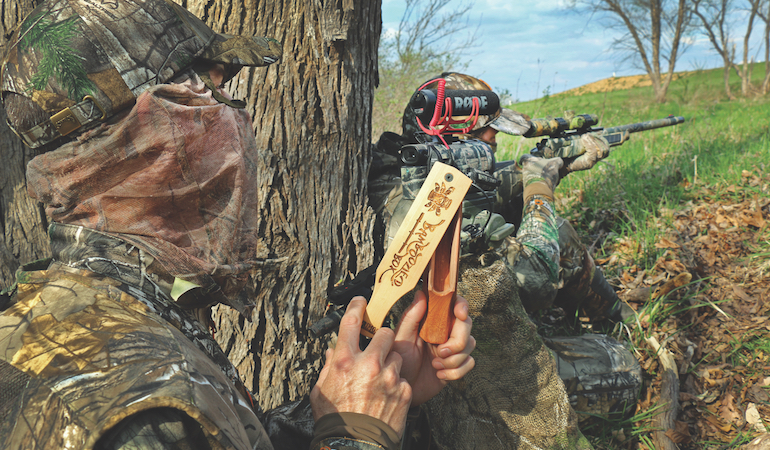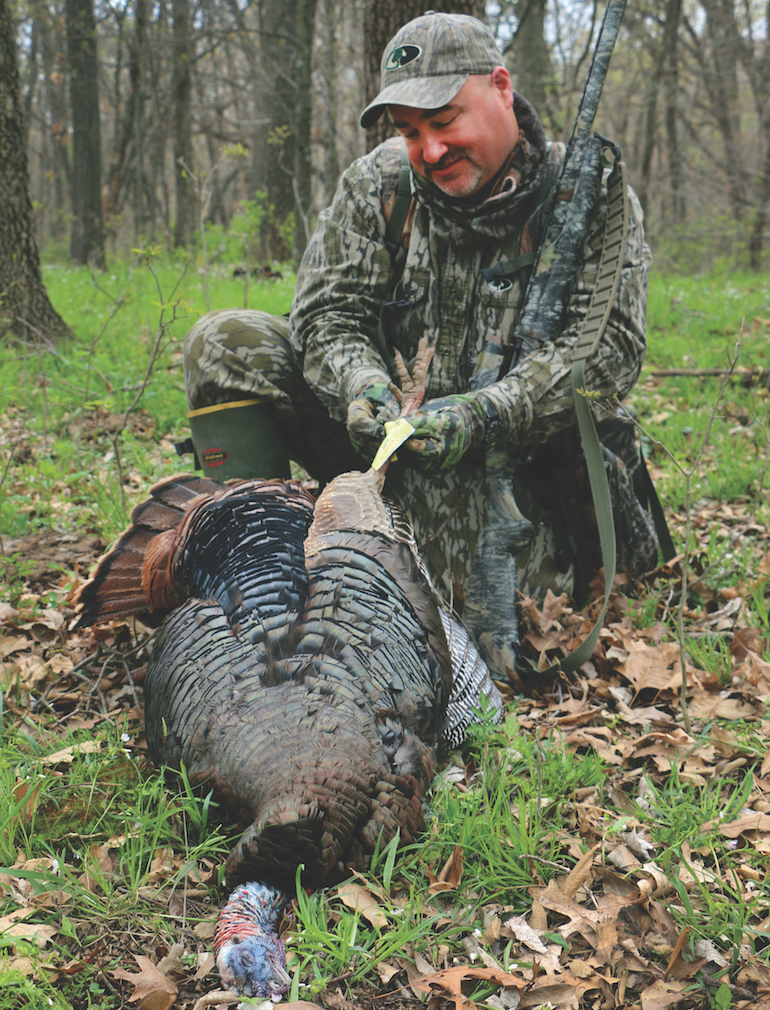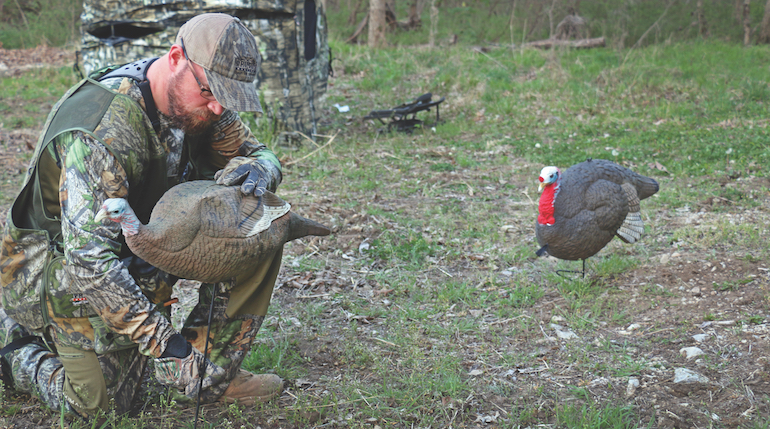
Bringing a gobbler sure-kill close in the woods might be the biggest thrill in hunting. (Photo by Brian Lovett)
Good setups kill turkeys. Poor setups blow opportunities and leave hunters wondering what might have been.
Don’t sit at the wrong tree or place your blind at a lousy spot this spring. Consider these deadly setups for common turkey-hunting situations, and then adapt them to your area.
TIMBER SEARCH
Bringing a gobbler sure-kill close in the woods might be the biggest thrill in hunting. And big timber in hilly or rolling terrain can be a caller’s dream. However, many people fail in this scenario because they want to set up at a relatively open area where they can see turkeys at long distances. That lets an approaching gobbler see the source of the calling while still out of range, and when it doesn’t see a hen, the bird instinctively knows something’s amiss and won’t come in.
In the woods, look for spots where terrain variation, understory vegetation, thick timber, a bend ina logging road or another visual obstruction hides the calling source — you — from an approaching gobbler until it’s in range. An interested tom will search for the noisy hen until he can see her. When he clears the obstruction that blocks his view, he’ll typically stop, raise his head and search for his new girlfriend. You can shoot him the instant he appears, provided you’re set up in easy range of where he’ll clear the obstruction.
Twenty-five to 35 yards is about perfect. Don’t get too close because the bird will likely spot you immediately, complicating your shot opportunity. And don’t set up too far, as the turkey will be hesitant to approach closer.
- Click here to subscribe to Game & Fish magazine
This type of setup requires that you track the turkey by sound — that is, gobbling — and, when he’s close, nonverbal clues. If he gobbles all the way to the gun, great. However, approaching birds often go quiet when they move, so if that happens, get your gun ready, and listen for drumming or footfalls in the leaves.
Also, leave the decoys at home. They don’t work well in the woods, as they almost seem to surprise turkeys that stumble across them.
HIGH HOPES
Roosting a turkey in the evening and setting up close the next morning puts you well ahead of the game. However, you can rarely be sure where the turkey will fly down, and if you’re in the wrong spot, the hunt might end poorly.
Use this rule: In areas with ridges, hills, ravines or coulees, turkeys will almost always fly down to the “short side” of the terrain. For example, a gobbler roosted along a steep ridge will typically sail down to the high portion of the incline because it’s far closer than the lower elevations of the slope. Often, they’ll land just short of the peak.
Search for likely landing areas, such as open patches of woods or logging roads. Or, at least find a good calling position close to where the turkey might touch down. Wherever you set up, make sure you can access it quickly and quietly in the dark. Get there well before light and remain as still as possible.
If the gobbler lands within range, shoot it immediately. If it stops short or sails out of range, be ready with a call to lure it closer.
Here’s another roost setup tip: During windy mornings, set up upwind from roosted turkeys, as they often like to fly down into the wind, much like a duck approaching decoys. You’ll be surprised how often this works.

PROPERTY-LINE FIELD BLUES
Here’s a tricky but common spring scenario: Gobblers frequently feed in a large cornfield across the property line from a tilled field you can hunt. They don’t typically cross the line, and there’s little set-up cover on the edges of your field.
Give them a reason to visit — specifically, a jake decoy placed near a hen decoy. Jakes seem to consistently spark aggressive reactions from spring gobblers. Strutter decoys work well sometimes, but they can also frighten or deter gobblers that have been whipped by jakes or other toms. And hen-only setups often get indifferent reactions.
- Click here to read more turkey hunting articles
The first key to this setup is placing the jake and hen where turkeys in the neighbor’s field can see them. Small ridges or slight high spots work best. Of course, those aren’t always near cover, so it’s probably best to hunt out of a popup blind. Set it where you can shoot a gobbler after it crosses onto your property, and place the decoys about 30 yards farther, so the turkey will walk past in range on his way to the jake. That way, you can still shoot him if he hangs up a bit.
The second, and probably most critical, consideration is setting up in the field undetected. Getting in well before dawn solves this. If you have to hunt at midday or evening, glass the field thoroughly to make sure turkeys can’t see your approach.
GREEN-FIELD PINCH
Secluded or hidden fields or arms of fields bordered by timber can be golden. Turkeys sometimes roost near these spots, feed in them after flydown and then loaf in the nearby timber. Or, they might cross through the open areas at any time of day, grabbing a bite to eat or looking for a hen.
Setting up at such spots combines elements of timber hunting and open-field scenarios. You have good cover, and turkeys often can’t see the calling source until they’re relatively close. But when they enter the field or can see it, you’ll want a decoy to provide visual reassurance. And because the field is bordered on two sides by woods, you have to worry about birds coming from both directions.
Again, set jake and hen decoys at a visible spot in the field, and back off to about 30 yards, whether you’re sitting at a tree or using a blind. Angle your setup so you can cover each possible approach route, and be ready for silent birds that might suddenly appear to check out your calling.
GET A GAME PLAN
As old-time turkey hunters say, “If you sit down wrong, you’ve already lost.” Don’t blow the game before it starts this spring. Identify solid setups, formulate common-sense game plans for those areas and visualize how those hunts might play out. You’ll experience far fewer frustrating what-if encounters and fill many more tags.

CALLING TIPS FOR EACH SETUP
- Woods Hunt: Many folks advocate calling just enough to keep a turkey coming, and that’s solid thinking. In this scenario, however, you’ll have to track the bird by its gobbling, so consider getting a bit more chatty. Fire him up with aggressive yelping and cutting. If he digs it, give it to him until he’s in range. Or, if needed, switch to soft clucking and purring to lure in shy birds.
- Roost Hunt: If you’re so close to a roosted turkey it can look down and see you, don’t call until the bird flies down. If you’re a bit farther, you can give him one or two series of soft tree yelps to see how he reacts. If he responds, shut up, because he knows exactly where you are. Don’t start the serious calling until he lands.
- Open-Field Hunt: If turkeys are fairly far away, use a loud box or pot call to get their attention. Call relatively aggressively with yelping and cutting to make birds look so they’ll see your decoys. As they start to approach, you can tone things down. Often, long periods of silence prompt turkeys to move more than consistent calling.
- Hidden-Field Hunt: In this case, call often enough to keep birds approaching. Yes, you’ll want to track their approach by making them gobble, but having turkeys see your decoys and commit the final few yards is really the key to this hunt. Get them interested, and get more subtle or aggressive as needed to keep them on the string.








